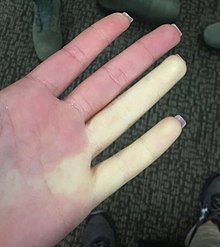| Raynaud syndrome | |
|---|---|
| Other names | Raynaud's, Raynaud's disease, Raynaud's phenomenon, Raynaud's syndrome[1] |
 | |
| The hand of a person with Raynaud syndrome during an attack. | |
| Pronunciation | |
| Specialty | Rheumatology |
| Symptoms | An affected part turning white, then blue, then red, burning[2] |
| Complications | skin sores, gangrene[2] |
| Usual onset | 15–30 year old, typically females[3][4] |
| Duration | Up to several hours per episode[2] |
| Risk factors | Cold, emotional stress[2] |
| Diagnostic method | Based on the symptoms[3] |
| Differential diagnosis | Causalgia, erythromelalgia[5] |
| Treatment | Avoiding cold, calcium channel blockers, iloprost[3] |
| Frequency | 4% of people[3] |
| Named after | Maurice Raynaud |
Raynaud syndrome, also known as Raynaud's phenomenon, is a medical condition in which the spasm of small arteries causes episodes of reduced blood flow to end arterioles.[1] Typically the fingers, and, less commonly, the toes, are involved.[1] Rarely, the nose, ears, nipples, or lips are affected.[1] The episodes classically result in the affected part turning white and then blue.[2] Often, numbness or pain occurs.[2] As blood flow returns, the area turns red and burns.[2] The episodes typically last minutes but can last several hours.[2] The condition is named after the physician Auguste Gabriel Maurice Raynaud, who first described it in his doctoral thesis in 1862.[6]
Episodes are typically triggered by cold or emotional stress.[2] Primary Raynaud's is idiopathic (spontaneous and of unknown cause) and not correlated with another disease. Secondary Raynaud's is diagnosed given the presence of an underlying condition and is associated with an older age of onset. [3] In comparison to primary Raynaud's, episodes are more likely to be painful, asymmetric and progress to digital ulcerations.[7] Secondary Raynaud's can occur due to a connective-tissue disorder such as scleroderma or lupus, injuries to the hands, prolonged vibration, smoking, thyroid problems, and certain medications, such as birth control pills and stimulants.[8] Diagnosis is typically based on the symptoms.[3]
The primary treatment is avoiding the cold.[3] Other measures include the discontinuation of nicotine or stimulant use.[3] Medications for treatment of cases that do not improve include calcium channel blockers and iloprost.[3] There is little evidence that alternative medicine is helpful.[3] Severe disease may in rare cases lead to complications, specifically skin sores or gangrene.[2]
About 4% of people have the condition.[3] Onset of the primary form is typically between ages 15 and 30 and occurs more frequently in females.[3][4] The secondary form usually affects older people.[4] Both forms are more common in cold climates.[4]
- ^ a b c d "What Is Raynaud's?". nhlbi.nih.gov. US: National Heart, Lung, and Blood Institute, National Institutes of Health. 21 March 2014. Archived from the original on 4 October 2016. Retrieved 1 October 2016.
- ^ a b c d e f g h i j "What Are the Signs and Symptoms of Raynaud's?". nhlbi.nih.gov. US: National Heart, Lung, and Blood Institute, National Institutes of Health. 21 March 2014. Archived from the original on 5 October 2016. Retrieved 1 October 2016.
- ^ a b c d e f g h i j k l Wigley FM, Flavahan NA (11 August 2016). "Raynaud's Phenomenon". The New England Journal of Medicine. 375 (6): 556–65. doi:10.1056/nejmra1507638. PMID 27509103.
- ^ a b c d "Who Is at Risk for Raynaud's?". nhlbi.nih.gov. US: National Heart, Lung, and Blood Institute, National Institutes of Health. 21 March 2014. Archived from the original on 5 October 2016. Retrieved 1 October 2016.
- ^ Barker RA (2005). The A-Z of Neurological Practice: A Guide to Clinical Neurology. Cambridge University Press. p. 728. ISBN 9780521629607. Archived from the original on 24 April 2017.
- ^ Koehler U, Portig I, Hildebrandt O, Koehler NA (December 2019). "Maurice Raynaud (1834-1881) and the Mystery of 'Raynaud's Phanomenon'". Dtsch Med Wochenschr (in German). 144 (25): 1778–1783. doi:10.1055/a-0869-9899. PMID 31847013. S2CID 209409136. Archived from the original on 28 November 2022. Retrieved 4 October 2023.
- ^ Temprano KK (March 2016). "A Review of Raynaud's Disease". Missouri Medicine. 113 (2). Missouri State Medical Association: 124. ISSN 0026-6620. OCLC 790281069. PMC 6139949. PMID 27311222.
- ^ "What Causes Raynaud's?". nhlbi.nih.gov. US: National Heart, Lung, and Blood Institute, National Institutes of Health. 21 March 2014. Archived from the original on 4 October 2016. Retrieved 1 October 2016.